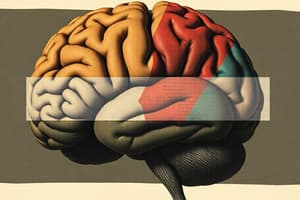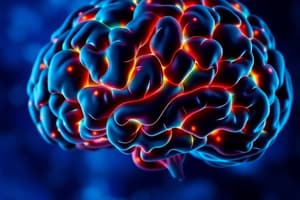Podcast
Questions and Answers
Which lobe of the brain is responsible for cognition?
Which lobe of the brain is responsible for cognition?
- Parietal Lobe
- Frontal Lobe (correct)
- Temporal Lobe
- Occipital Lobe
Which area of the brain is responsible for language production?
Which area of the brain is responsible for language production?
- Broca's Area (correct)
- Primary Auditory Cortex
- Primary Motor Cortex
- Wernicke's Area
The left side of the brain controls the right side of the body.
The left side of the brain controls the right side of the body.
True (A)
What is the primary function of the occipital lobe?
What is the primary function of the occipital lobe?
The ______ separates the frontal and parietal lobes.
The ______ separates the frontal and parietal lobes.
What term describes the crossing of nerves from one side of the body to the other?
What term describes the crossing of nerves from one side of the body to the other?
What is the most common neurotransmitter in the brain?
What is the most common neurotransmitter in the brain?
Approximately how many neurons are in the human brain?
Approximately how many neurons are in the human brain?
Sodium (Na+) and Potassium (K+) are ions involved in ______ activity of neurons.
Sodium (Na+) and Potassium (K+) are ions involved in ______ activity of neurons.
What is the status of a neuron at rest in terms of voltage?
What is the status of a neuron at rest in terms of voltage?
Which part of the nervous system is responsible for processing touch sensations?
Which part of the nervous system is responsible for processing touch sensations?
Flashcards are hidden until you start studying
Study Notes
Neuroscience Rules
- The brain has a symmetrical design, meaning that structures on the left side of the brain mirror those on the right side.
- Specific brain regions are responsible for specific functions, known as localization of function.
- The brain has four lobes:
Frontal Lobe
- Responsible for cognition, language, and movement.
- The prefrontal cortex plays a key role in cognition.
- Broca's area is responsible for language production.
- The primary motor cortex controls movement.
Parietal Lobe
- Responsible for processing touch information.
- The primary somatosensory cortex receives touch sensations.
Occipital Lobe
- Responsible for processing visual information.
- The primary visual cortex (V1) is the first stage of visual processing.
Temporal Lobe
- Responsible for language and auditory processing.
- Wernicke's area processes language comprehension.
- The primary auditory cortex processes sound information.
- The brain uses a contralateral control system, where movements on one side of the body are controlled by the opposite hemisphere of the brain.
- The brain exhibits topographic organization, meaning neurons responsible for specific functions are arranged in a highly ordered manner.
Motor Homunculus
- Found in the frontal lobe.
- Represents the body's motor map, with larger areas dedicated to regions with more fine motor control.
- Areas like the hand, face, thumb, and fingers are larger here.
Sensory Homunculus
- Found in the parietal lobe.
- Represents the body's sensory map, with larger areas dedicated to regions with greater sensitivity.
- The brain has several defining features:
- Weighs approximately 3lbs.
- Contains roughly 100 billion neurons.
- Each neuron has a cell body diameter of 10 micrometers.
- Constitutes about 20 watts of power in the human body.
Navigating The Nervous System
-
Positional terms:
- Superior: Above
- Inferior: Below
- Posterior: Behind
- Anterior: In front of
- Dorsal: To the back
- Ventral: To the stomach
- Rostral: To the forehead
- Caudal: To the back of the head
- Midline: Divides the left and right sides of the body
- Medial: Close to the midline
- Lateral: Far from the midline
- Decussate: Crossing from one side of the nervous system to the other.
- Ipsilateral: On the same side.
- Contralateral: On opposite sides.
- Proximal: Close to the point of reference.
- Distal: Far from the point of reference
- Efferent: Leaving the point of reference.
- Afferent: Going towards the point of reference
-
Planes of Section:
- Coronal/Frontal: Cut from left to right ear.
- Sagittal: Cut from the nose to the back of the head
- Horizontal: Cut through the eyes.
- Gyrus: The peaks of the brain.
- Sulcus: The grooves of the brain.
- Central sulcus: Separates the frontal and parietal lobes.
- Lateral Sylvian fissure: A deep sulcus that separates the frontal/parietal lobes from the temporal lobe.
The Neuron
- Contains a resting membrane potential of -65 millivolts.
- Glutamate is the most abundant neurotransmitter in the brain.
- The interior of the neuron has a negative charge relative to the exterior.
- Sodium (Na+), Potassium (K+), Chloride (Cl-), and Calcium (Ca2+) are vital for neuronal electrical activity.
Neurons and Other Cells
- Similarities:
- Both have a lipid bilayer membrane for structure.
- Both contain basic organelles like the nucleus and mitochondria.
- Differences:
- Neurons have a unique morphology with dendrites and an axon.
- Dendrites receive neurotransmitter signals.
- Axons transmit signals to other neurons.
- Neurons are specialized for communication.
Studying That Suits You
Use AI to generate personalized quizzes and flashcards to suit your learning preferences.




